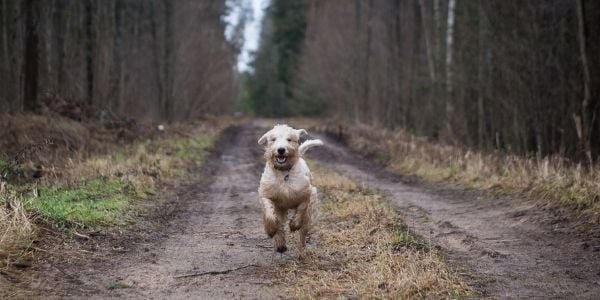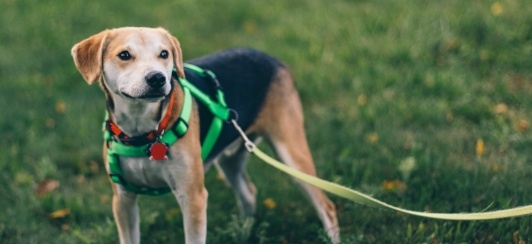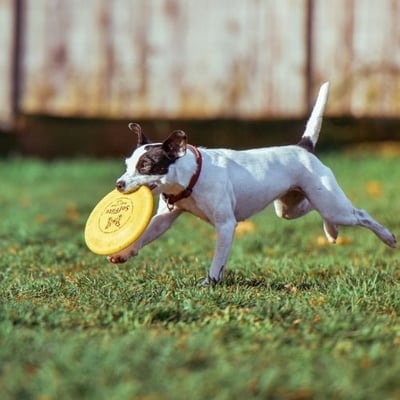
Being able to trust your dog off leash is a goal of many dog owners.
But there are quite a few worries, shared by many, about unclipping the leash and letting your dog run free.
What if your dog runs away and doesn't come back?
What if they get lost?
What if they get injured?
What do you need to train before off leash is an option?
There are risks to letting your dog off leash, which may change based on what environment you're in. And the choice to let a dog off leash is really one based on your own tolerance of those risks.
But there are also important considerations of local leash laws and ensuring your dog doesn't cause other people or animals distress (even inadvertently).
Skip Ahead
If you're wondering whether your dog is ready to be allowed off leash freedom, read on for advice on what training foundations they need and the benefits and risks of letting your dog off leash.
This way you can weigh the pros and cons and decide whether unclipping the leash is safe and appropriate for you and your dog.
How to Tell if Your Dog is Ready for Off Leash
This might be an unpopular sentiment, but many dog trainers would agree that most dogs, including puppies, are given the privilege of being off leash way too early and before they're ready.
While it might seem desirable for exercise purposes, relieving your arm of all the pulling and playful energy, many dogs just aren't ready yet for off leash privileges.
Here are the first things I ask my training clients to consider when they are wanting to make the leap to off leash with their dog:
- Is your dog spayed or neutered? Intact dogs often exhibit strong desires to roam and mate — it's instinctual! The last thing you want is for your dog to — ahem — "get it on" with another dog they may come across while off leash.
- Are your dog's ID tags and microchip updated? In case your dog gets lost or runs off, it's so important to make sure that anyone who finds them can contact you quickly. Learn how to update your dog's microchip information here.
- Is your dog fully vaccinated and on flea and tick preventatives? It's important to protect your pup against parasites and the illnesses transmitted by these parasites while they are enjoying the outdoors. And in case your dog does run into a skunk or other wildlife, being fully vaccinated is essential to help protect against disease.
- Where are you wanting to take your dog off leash? City environments are, in my opinion, much too busy and unpredictable to be safe for a dog off leash. Rural areas can be a safer choice, but they have their own risks, such as wildlife or livestock.
- Is it legal to take your dog off leash in that area? Many areas, from small city parks to state and national parks, do not allow dogs to be off leash. Please obey the leash laws! It does not matter if your dog is "perfect" off leash, it's still not okay to let them off leash where it's not allowed.
Not sure if the area you're in has leash laws? It's always better to err on the side of caution and keep your pup on a leash. - How does your dog do with more freedom? Using a long leash is one way to test out how your dog will do with more freedom on your outdoor and unleashed adventures.
Long leashes come in a variety of lengths, mimicking an off-leash experience while still providing you with a safety line attached to your dog. One of my favorites is this biothane long leash, and you can see more of my recommendations for long leads here.
If available in your area, enroll in intermediate and advanced training classes with a certified professional dog trainer. Many of these higher-level classes include practicing cues off leash around different distractions, but in a more controlled environment.
Another option is to visit a large, fully-enclosed/fenced area with your dog to watch how they act and respond to you when off leash.
Do they check in on their own? Do they come when called? Do they trot along with you as you wander? Even if you don't have a fenced yard to practice, you can use SniffSpot to rent out private and fenced outdoor spaces. - Optional: Should your dog wear a GPS collar? There are more and more products becoming available (and getting more affordable) that give you an easy way to track your dog in the case they do run off or get lost.
My dogs wear a FitBark GPS Dog Tracker when we go hiking, and it helps me keep track of their daily activities and calories burned.
There are quite a few options, and some are better than others depending on whether you go hiking in the backcountry or stick around where there is cell tower coverage.
But having one more way of finding your pup if they wander off may help put your mind at ease.
Off Leash Training Tips
What Your Dog NEEDS to Know Before Being Allowed Off Leash
Reliable Recall: Before your dog can safely join you for off-leash adventures, they need to have a rock-solid come-when-called cue. No ifs, ands, or buts about it!
And when I say "rock-solid," that means being able to come when called even when they are in the middle of chasing a squirrel.
When you first start training your dog to come when called, you'll want to start easy and then work up to more difficult recalls. Begin inside, then practice room to room. Take it out into a fully fenced yard.
Practice while you're out on leashed walks. Use a long leash to mimic the feeling of being unleashed. Get your practice in any and everywhere, consistently rewarding your dog for coming away from different distractions.
This takes time and lots of practice, so don't feel rushed to allow your dog off leash before you know that they are a recall rockstar. Learn more about how to train your dog to come when called here.

Leave It and Drop It: These two closely related cues are especially handy for when your dog may see something rather enticing that they want to put in their mouth — or after they've already decided to grab it!
Whether that's leaving surrounding wildlife alone, not eating any "droppings" they may come across (which can be filled with parasites and bacteria), or dropping the delicious bits of trash they may have found. Check out Teach Your Dog to Leave It and Teach Your Dog to Drop It for steps on how to brush up on these skills.
Staying Close and Checking In: Being off leash for a dog means they can meander and wander away from you. They naturally walk faster than us and tend not to stick to any straight path.
For safety's sake, it's important to keep them within your line of sight so you can call them back if needed. Having a dog who tends to stay close by and check-in with you intermittently makes off-leash time much easier for all.
Consider whether your dog tends towards being more independent or likes to stick close by to you when you're out in the yard, on long-leash walks, or at the dog park.
This can give you an idea of how likely they are to stay close to you when off leash. You can encourage check-ins by teaching your dog name recognition and cueing them to look at you.
Take advantage of a training method called "capturing" by saying yes and giving them a treat whenever they turn to look at you without being asked on walks.
Other Helpful Training Cues for Off-Leash Dogs
- Sit or Down that you can cue from a distance
- Stay
- An Off-Leash Heel
Spending off leash time with your dog means you'll need to keep some supplies handy, like treats, leashes, poo bags, and water. Check out these hands-free "dog training belt" hacks so you're always prepared!

Benefits of Allowing Your Dog to Off Leash
- Being off leash allows a dog to move more freely and at their natural pace. A dog can develop more confidence when they feel they have more choice in how they explore.
Plus, they tend to burn more energy when off leash than on leash as they run this way, that way, and back to you.
- Off-leash interactions with other dogs are more "natural" in regards to body language.
I much prefer off-leash greetings (where ALL dogs involved are off leash or dragging leashes) to on-leash dog introductions because of the inherent removal of a dog's flight option if they feel overwhelmed or unsure.
With that being said, never let your off-leash dog approach another dog who is on leash. - Many dog owners find it more convenient to let their dog off leash than to have to manage their dog on a leash.
It's certainly easier to simply not keep a hold of your dog when you're making a quick trip to the mailbox and can trust them to not run off on their own.
Risks of Allowing Your Dog Off Leash
Before you “release the hounds,” recognize that it's not just your dog that's exposed to risk when they're off-leash — plenty of other dogs (including service dogs), people, and wildlife have been injured or emotionally scarred by an off-leash dog.
So please, be considerate and always pay attention to and follow posted leash law signs and rules.
Here are just some risks of letting your dog off leash:
- Your dog could bolt or run away, especially if startled by a loud noise.
- A dog can wander into traffic and be hit by a car.
- On hikes, an off-leash dog could startle a horse and rider.
- Your dog may go after wildlife, resulting in injury to themselves or to the animal they encounter.
- Some dogs exhibit predatory behavior towards domesticated animals or livestock. Be aware that many livestock owners will shoot a dog who is going after their animals — and in many areas, it is legal for them to do so.
- Off-leash dogs can fall over cliffs (this has actually happened to a Preventive Vet team member's dogs!), or steep slopes, resulting in injury or worse. They may fall into fast-moving rivers.
- Your dog may rush to greet another dog, potentially ending in a dog fight.
- An off-leash dog approaching a reactive or aggressive dog can ruin that dog's rehabilitation and training*.
- A "friendly" dog may rush up to other people. Many people do not appreciate this, especially if they are scared of dogs or have past negative experiences with unleashed dogs.
- An off-leash dog can ingest rodenticides, poisonous mushrooms, or other toxic items while out on their foray.
*As a canine behavior consultant, I work with many leash reactivity and aggression cases. It is my biggest pet peeve to see dog owners ignore leash laws and allow their dogs to run off leash with no regard to others.
I could write a book with how many times I've had to prevent an off-leash dog (who should not have been allowed off leash because of the environment or because of their lack of training) from running up to my clients and their leashed dog.
Owners of reactive dogs are doing their best to rehabilitate their dogs, and they are spending lots of money and putting in many hours of work to do so. One off-leash dog can ruin all of their progress.
If your dog is off leash and you see another dog, you must recall your dog. It does not suffice to yell, "my dog is friendly!"
If your dog will approach the other dog, put them on leash until the leashed dog is no longer in view. This is a courtesy that would solve a lot of problems, and prevent a lot of dogs and people from getting hurt.

What to Do If Your Dog Starts to Run Away
This is always the big worry: Your dog has spotted something (squirrel!) and takes off.
Your instinct will be to shout and holler and go running after them, but this instinct is wrong. Resist it. Here's what you should do:
- Be calm: If you sound fearful or angry, your dog will be less likely to come back than if you sound welcoming and excited.
Think about it, would you want to go toward someone who’s screaming at you or someone who sounds like they want to play and offer you treats? - Show you’ve got treats: Give your dog extra incentive to come back. If they're a little further away, the sound of you shaking or rustling the treat bag may help trigger their interest.
- Use your recall cue: This is why it’s so important to make sure your dog really and reliably understands that “come” means they'll get treats and praise when they return to you.
Extra worried about whether they'll come back? Consider training an Emergency Recall. - Don’t chase: There’s little chance you will be able to outrun your dog. More likely than not, you'll only encourage them to run faster and farther if they think this is now a game of chase.
Worst of all, a dog who is trying to outrun you will pay less attention to possible dangers in front of them — like cars! - Turn away from them: It may seem counterintuitive, but if your dog is running away from you, sometimes your best bet is to turn and move away from them. Act like you’re heading back to the car or going home, and make it seem like you’re having the best time ever in the process.
Think of what you normally do to get your dog excited and ready to play, then do that. You’re not trying to leave them; you're trying to make them think there’s something way more interesting where you are and where you're going.
You've got to make yourself, where you're at, and what you're doing more interesting than whatever it is your dog is doing and/or chasing — so be convincing! - Praise! No matter how frustrated, scared, or angry you are, when your dog does come back to you, praise them and give them a treat. At this point, you're not rewarding them for taking off, you're rewarding and praising the fact that they came back!
Don't worry, you won't be encouraging bad behavior. Quite the contrary ... if you scold, berate, or otherwise punish your dog when they come back, they're far less likely to return the next time.
(But, of course, there's also little chance that there will be a "next time" — as you'll go back to work a bit more on their off-leash recall in a more controlled/contained environment. Right?)
Your Dog Doesn't Need to Be Off Leash — What to Do Instead
As I mentioned earlier on, letting your dog off leash is all about whether you're okay with the risks involved with doing so. I tend to be rather risk-averse (and a bit of a worrywart).
I do not allow my dogs off leash when not in a secure, fully-fenced area. It's less about whether I trust my dogs and more that I can't control the rest of the world.
Plus, I know that my dogs aren't machines. They are living creatures with their own desires, instincts, and behavior.
And if they follow certain instincts, that can put them at increased risk of danger, especially in our suburban area with traffic and urban wildlife (a pack of coyotes lives just down the street from us in a state park).
So instead, I take my dogs on lots of walks and sniffaris. We go on lots of hikes using long leads (check out the short video of this below). We visit different SniffSpots so they can run off leash in securely fenced areas.
I try to incorporate short and sweet training sessions into their routine every day, along with lots and lots of mental enrichment. We try out different training classes and dog sports, like Barn Hunt and fastCAT.
My dogs aren't missing out on anything by being attached to me with a leash while we're out walking or hiking. It may be less convenient for me, but holding onto a leash is worth knowing that I'm doing all I can to keep them safe and other people and pets comfortable.



